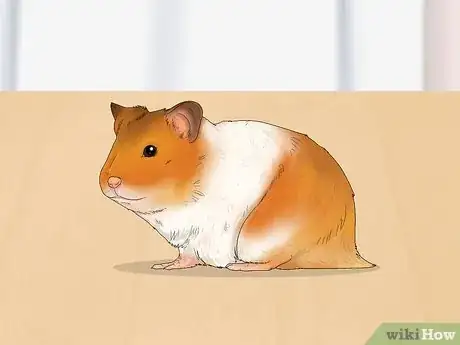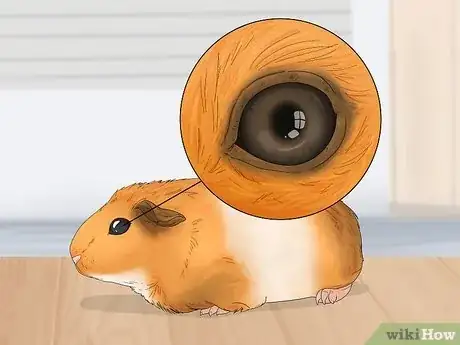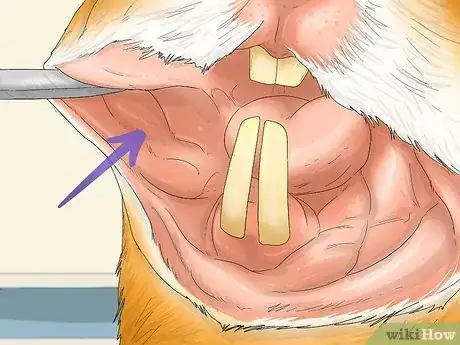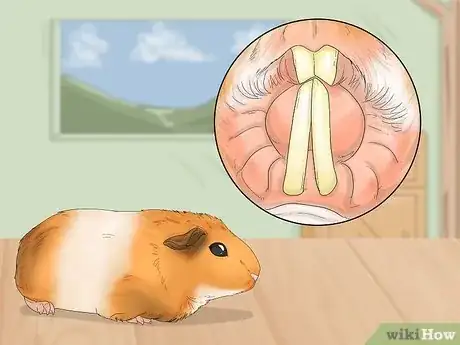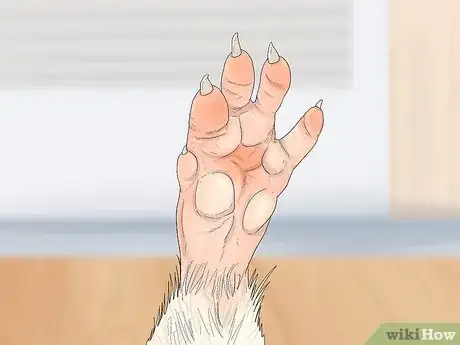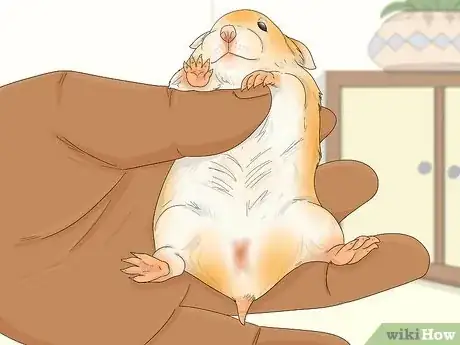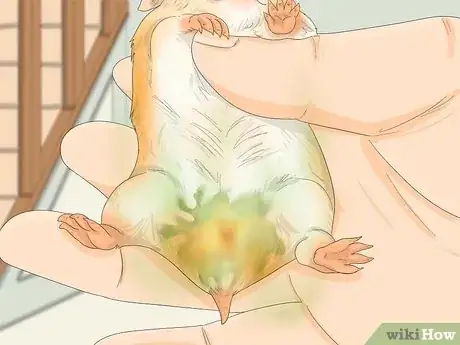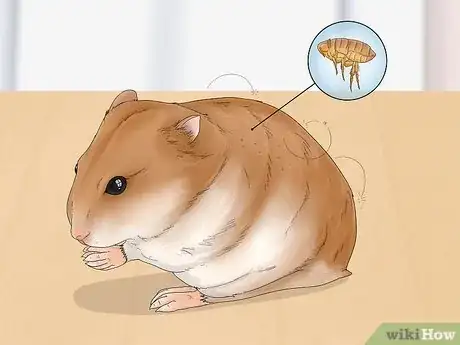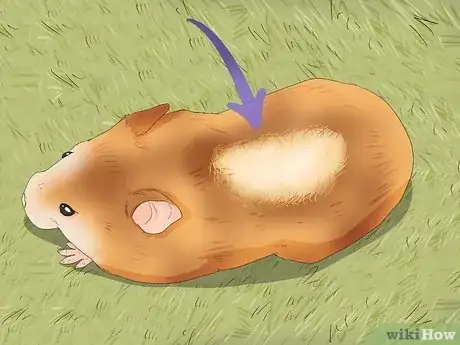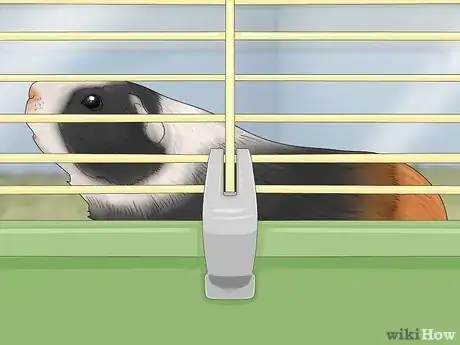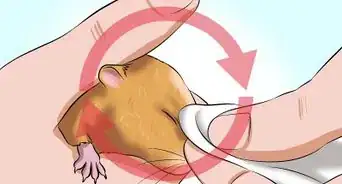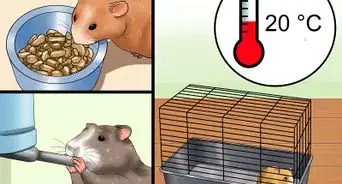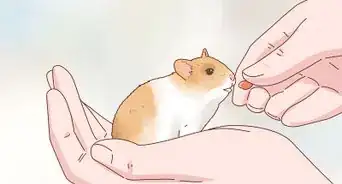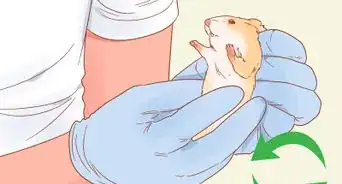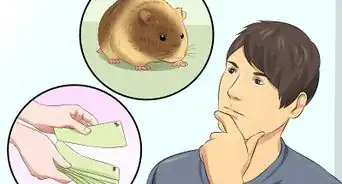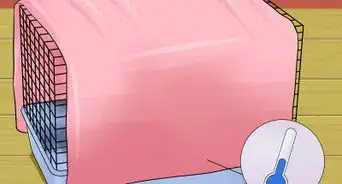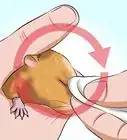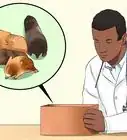X
wikiHow is a “wiki,” similar to Wikipedia, which means that many of our articles are co-written by multiple authors. To create this article, 14 people, some anonymous, worked to edit and improve it over time.
This article has been viewed 2,398 times.
Learn more...
Hamsters are delicate animals that can get ill or injured fairly easily, so it is important to carry out regular check-ups to ensure they can live the longest and happiest life possible. Your hamster will rely on you for their entire life, and that includes for their health and well-being. Knowing how to perform an easy check up on your hamster will not only keep you in the know, it may even save your furry friends life!
Steps
-
1Put your hamster on a safe, flat surface. Keep them away from any high-falls or other animals that could possibly injure the rodent. Places such as a table or even a playpen would work best.
-
2Occupy them with a treat they like. It is possible for them to get annoyed or scurry off as you are messing with them. So giving them a treat they like will not only distract them but make them feel rewarded as well! Just be sure to give treats in moderation as giving them too many can make them overweight and possibly lead to diabetes depending on the species of hamster.Advertisement
-
3Check the hamster's eyes. Take a good look at your hamsters eyes. Their eyes should be bright and clear. Be sure there isn't any discharge or crust around either eye and check for any bulging or redness. Observe your hamster to see if they are scratching or pawing at their eyes, this could be a sign something is bothering them. Look for grey or dull patches in their eye that can indicate cataracts.[1]
- It is also a good idea to check and see if their eyelids work properly, you can do this by gently blowing on their face. They should automatically close their eyes and blink when you do this if their eyelids are in good shape. If the eyelid looks puffy or has trouble closing completely, contact your veterinarian.
-
4Take a look at their ears and nose. Hamsters can be prone to ear mites and dry skin in their ears. Check each ear for dry and flaky skin to see if they have a dry skin issue. Both ears should be clean and have no smell or discharge. Look for dark ear wax or hair loss in and around the ears, which could indicate an ear mite infestation.[2]
- Check out their nose as well. A very wet or runny nose could be a sign of allergies or a cold. They might also be irritated by dusty or strong-smelling bedding, so make sure you are using suitable bedding for your hamster.
-
5Check the hamster's cheek pouch. They are often, but not always, a bit puffy from them storing food and treats inside their mouth. Check for extra bumps or bulges inside or outside their mouth. If you notice a bump try touching it, it may be an issue if you see your hamster flinch or if the bump doesn't move. If you notice any damaged or hanging flesh stop immediately and contact your vet as soon as possible.
-
6Try to get a good look at your hamster's teeth. A hamster's front teeth, also known as their incisors, should be an even length. They should be yellow, not white, and may continue to darken as your hamster ages. The top and bottom teeth should touch and be straight, not curled. If they curl over or are uneven, they might need to be trimmed by a veterinarian. Make sure there is no blood or signs of recent bleeding in or around their mouth. Check for any broken or misaligned teeth as well.[3]
- To check your hamsters teeth, gently pull back on your hamsters cheeks so that the teeth are exposed. If you notice their teeth are starting to get long try adding some additional chews to their cage. They will gnaw on these to manually keep their teeth shaved down.[4]
- Broken or overgrown teeth are the most common dental problems in hamsters, and are dangerous to their health. Teeth complications may result in your hamster refusing to eat and require immediate attention.
-
7Look at the hamster's nails. Check out each of your hamster's paws and take a quick look at their nails. The nails should be straight and small. Overgrown claws can curl back and into your hamster's foot, causing pain and discomfort if not treated. If you notice that they are curved in a crescent-like shape, then take take them to your closest vet. Not only will they trim them for you, they will also give you tips to trim them yourself and keep them shaved down.
-
8Take a look at the hamster's bottom and belly. Hold your hamster and inspect their underside. Their belly should appear normal and not have any discoloration, swelling or bruising. A hard or bloated belly combined with decreased urination could be a sign of urinary blockage. Look for anything stuck to your hamster's butt. It should not be wet or have feces, blood, or discharge.[5] If you notice any of these try taking them to your vet as soon as possible.
- A dirty or wet bottom can indicate a condition known as wet tail. This is often brought on by stress and is more common in Syrian hamsters, though it can effect any breed of hamster. wet tail is a serious condition that can be fatal without prompt veterinary attention. Other signs of wet tail include diarrhea, strange posture, lethargy, and weight loss.[6]
-
9Check the hamster's scent glands and genital area. A hamster's scent glands shouldn't have a strong odor, pus, or look sore. The location of these scent glands varies by species, so check a diagram of your hamster to locate them. Their genitals shouldn't look sore, have a strong odor, or have any pus. Male hamster's genitalia should be retracted and not visible, and their testes should not have any lumps or wounds.
-
10Look at the hamster's fur and coat. Your hamster's coat should look healthy, with thick fur and a slight shine. There shouldn't be any bald batches or knotted fur. Hair loss is normal for hamsters over 18 months, but can be a sign of other problems in young hamsters. Observe your hamster to see if they scratch themselves a lot. If you see any black dust in their fur or tiny jumping insects on them, you might be dealing with a flea infestation.
- If your hamster develops a bald spot above their nose and they live in a bar cage, consider upgrading your cage or providing more enrichment. It is likely a result of bar chewing, which can be a result of boredom, a cage that is too small, or not giving them enough attention.
-
11Check the hamster's skin. There should be no flaky, dry, or crusty patches of skin. Dry and scabby skin combined with thinning or balding fur might indicate sarcoptic mange, a painful skin condition caused by mites.[7] Look for any irritation, cuts, or scrapes anywhere on their body. Gently feel around for any unusual new lumps, bumps or swollen areas that could be a sign of a tumor.
-
12Return your hamster to their enclosure. Once you've finished looking over your hamster, return them to their cage. If you haven't given too many treats yet, offer a small snack to reward them for their cooperation. Try to repeat this health check every week to ensure you don't miss any symptoms before they turn into a serious issue. Continue to observe your hamster for a short time every day to look for any changes in behavior or appetite.
Advertisement
Warnings
- If there is any urgent problem, don't hesitate to take your pet either to a pet emergency room or to your vet right away.⧼thumbs_response⧽
- Make sure your hamster is already tame, untamed hamsters will not hesitate to bite and fight back.⧼thumbs_response⧽
- If you find anything wrong with your hamster, you should contact your vet and make an appointment if it is not urgent.⧼thumbs_response⧽
- Never try "At Home Remedies" on your hamster. Not only are they dangerous, it could make the issue worse.⧼thumbs_response⧽
Advertisement
References
- ↑ https://www.omlet.us/guide/hamsters/hamster_health_care/health_check/
- ↑ https://www.burgesspetcare.com/blog/hamsters/hamster-health-checks/
- ↑ https://www.rspca.org.uk/adviceandwelfare/pets/rodents/hamsters/health
- ↑ https://mooreanimalhospital.com/2014/04/01/larimer-county-vet-hamster-dental-health/
- ↑ https://www.merckvetmanual.com/all-other-pets/hamsters/routine-health-care-of-hamsters
- ↑ https://www.hamstersociety.sg/hamster-care-blog/2019/5/8/common-hamster-illnesses
- ↑ https://www.burgesspetcare.com/blog/hamsters/hamster-health-checks/
About This Article
Advertisement
